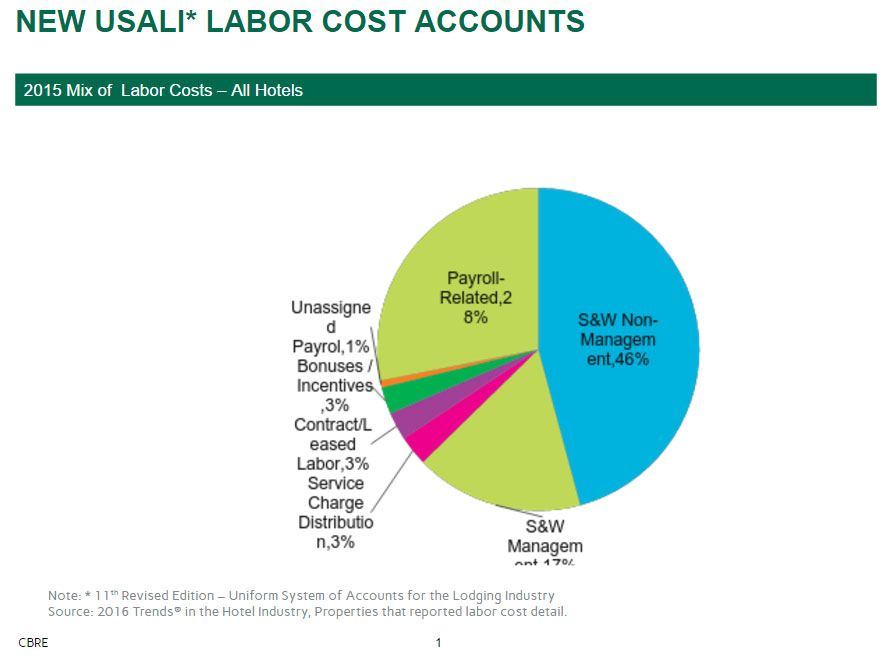USALI Changes Offer New Benchmarks
Every ten years or so, the Financial Management Committee (FMC) of the American Hotel & Lodging Association revises the Uniform System of Accounts for the Lodging Industry (USALI). The USALI serves as the industry standard for reporting hotel revenues and expenses.
Revisions to the USALI are necessary in order to keep up with changes in industry practice, as well as changes in accounting rules and regulations. In preparing the 11th revised edition of the USALI that was used by hoteliers to prepare their 2015 operating statements, the FMC addressed some industry changes that had occurred since the 10th edition that was released in 2006:
- Increased Use and Cost of Technology
- Cluster Services
- Sustainability
- Distribution Channels
- Increased Use of Analytics
- Globalization
- New Terminology
- Greater Exposure to Labor Costs
One of the primary purposes of the USALI is to provide the industry with a "common language" to allow for comparable benchmarking and analysis across different properties. Therefore, when the USALI changes, benchmarking companies like ourselves need to change our reporting. For the 2016 edition of CBRE Hotels' Americas Research's Trends
®
in the Hotel Industry survey, we added additional revenue and expense categories to capture the USALI changes to the reporting of labor costs, resort fees, and technology related expenses. In the following paragraphs we present the 2015 operating data for hotels that complied with the new USALI and reported data for these new revenue and expense categories.
Labor Costs
Labor Costs are the largest operating expense for hotels. In 2015 they averaged 42.8 percent of total operating expenses. In recognition of the impact of this expense on the profitability of hotels, the increased use of contract, leased and outsourced labor, and the need to provide greater exposure to the distribution of service charges to employees, the 11th edition of the USALI added several new lines items to the reporting of labor costs. Our Trends
® survey added these new labor cost line items as well.
In 2015, labor costs at the hotels in our sample were comprised of 71.9 percent salaries and wages, and 28.1 percent payroll-related costs (employee benefits). With the new USALI categories, we are able to get a better understanding of the salary and wage component of labor costs. During the year, 45.8 percent of total labor costs went towards the salaries and wages paid to non-management staff, versus 16.9 percent to management personnel. Contract, leased and outsourced labor comprised 2.8 percent of total labor expenditures, while another 2.7 percent was paid to employees in the form of bonuses and incentive payments.
Among the various property types we saw some variation in these percentages. Because of the relative large volume of banquet business, convention hotels spent the greatest portion of labor dollars distributing service charges to their employees. Partially attributable to the low total labor cost dollars, the monies spent on contract and leased labor was the highest as a percentage of total labor costs at limited-service and extended-stay hotels.
When analyzing the data by department, the greatest incidence of the use of contract and leased labor was found in the rooms and administrative and general departments. Housekeeping staffs are increasingly being outsourced which explains why 37.4 percent of the hotels in the sample reported contract/leased labor payments in the rooms department. Within the administrative and general department, functions like security, human resources, and accounting all have the potential to be performed by outside service providers.
As expected, service charges were most often distributed in the food and beverage department.
Resort Fees
Per the 11th edition of the USALI, resort fees are recorded in the miscellaneous income department. Previously, resort fees were frequently reported as rooms revenue, and therefore influenced the calculation of average daily room rates (ADR) and revenue per available room (RevPAR).
A total of 192 properties reported more than $5,000 in resort fees in our Trends
® survey. Of these, the majority (102) were resort hotels, but resort fees were also reported by convention, full-service and all-suite hotels. On average, resort fees represented 4.7 percent of rooms revenue, or 2.5 percent of total operating revenue in 2015.
As mentioned before, the movement of resort fees from rooms revenue to miscellaneous income impacts the reported ADR of a property. The 2015 average daily rate (without resort fees) for the hotels in our sample was $245.66. If resort fees were included in rooms revenue per the 10th edition of the USALI, then the 2015 ADR for these same hotels would have been $257.21, a difference of 4.7%.
Information and Telecommunications Systems
Not only is technology a growing expense item for hotels, modern computer systems are designed to be inclusive of services and functions throughout the hotel. Therefore, the FMC felt the monies spent in this area were worthy of increased exposure, and created a new undistributed department named information and telecommunications systems (IT). In 2015, information and telecommunication systems expenses averaged 1.3 percent of total operating revenue, or 2.1 percent of total operating expenses, at those hotels that reported IT department expenditures.
The new IT department captures a wide variety of expenses. During the year, 34.8 percent of IT department dollars went towards labor costs (IT personnel and phone operators), followed by 22.3 percent for IT systems within the undistributed department expenses, and 10.8 percent for IT systems within the operated departments. The cost of phone and internet service, when offered as a complimentary service for guests or for administrative use, is included in the IT department as well. Combined, these telecommunications costs comprised 17.1 percent of total IT department expenditures.
New Benchmarks
Changes to the USALI provide greater exposure to revenue and expense items that are growing in dollar value, and relevance. With the increased amount of data, industry participants can now benchmark the performance of their hotels in these critical areas.
Robert Mandelbaum
Director of Research Information Services
CBRE Hotels







